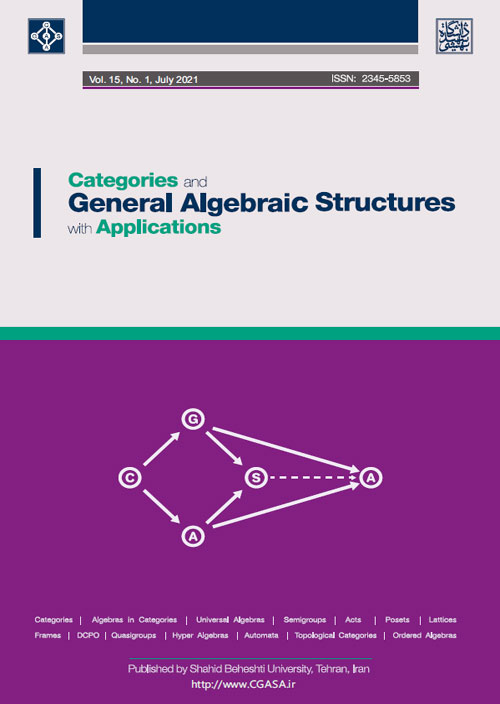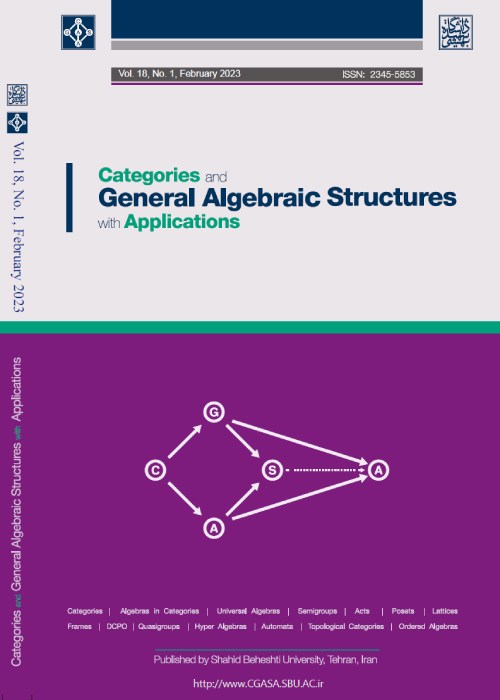فهرست مطالب

Categories and General Algebraic Structures with Applications
Volume:15 Issue: 1, Jul 2021
- تاریخ انتشار: 1400/05/10
- تعداد عناوین: 8
-
-
صفحات 1-34
-
صفحات 35-58
-
صفحات 59-92
-
صفحات 145-181
-
صفحات 183-229
-
صفحات 231-253
-
صفحات 255-272
-
Pages 1-34
The effect of the existence of a medial or related idempotent in any abundant semigroup is the subject of this paper. The aim is to naturally order any abundant semigroup $S$ which contains an ample multiplicative medial idempotent $u$ in a way that $mathcal{L}^*$ and $mathcal{R}^*$ are compatible with the natural order and $u$ is a maximum idempotent. The structure of an abundant semigroup containing an ample normal medial idempotent studied in cite{item6} will be revisited.
Keywords: Abundant semigroups, Ample semigroups, Medial idempotents, Naturally ordered semigroups -
Pages 35-58
Let $C(L)$ be the ring of all continuous real functions on a frame $L$ and $Ssubseteq{mathbb R}$. An $alphain C(L)$ is said to be an overlap of $S$, denoted by $alphablacktriangleleft S$, whenever $ucap Ssubseteq vcap S$ implies $alpha(u)leqalpha(v)$ for every open sets $u$ and $v$ in $mathbb{R}$. This concept was first introduced by A. Karimi-Feizabadi, A.A. Estaji, M. Robat-Sarpoushi in {it Pointfree version of image of real-valued continuous functions} (2018). Although this concept is a suitable model for their purpose, it ultimately does not provide a clear definition of the range of continuous functions in the context of pointfree topology. In this paper, we will introduce a concept which is called pre-image, denoted by ${rm pim}$, as a pointfree version of the image of real-valued continuous functions on a topological space $X$. We investigate this concept and in addition to showing ${rm pim}(alpha)=bigcap{Ssubseteq{mathbb R}:~alphablacktriangleleft S}$, we will see that this concept is a good surrogate for the image of continuous real functions. For instance, we prove, under some achievable conditions, we have ${rm pim}(alphaveebeta)subseteq {rm pim}(alpha)cup {rm pim}(beta)$, ${rm pim}(alphawedgebeta)subseteq {rm pim}(alpha)cap {rm pim}(beta)$, ${rm pim}(alphabeta)subseteq {rm pim}(alpha){rm pim}(beta)$ and ${rm pim}(alpha+beta)subseteq {rm pim}(alpha)+{rm pim}(beta)$.
Keywords: frame, Pointfree topology, $C(L)$, pre-image, prime ideal, maximal ideal in frames, $f$-algebra -
Pages 59-92
In this paper we study flatness properties (pullback flatness, limit flatness, finite limit flatness) of acts over semigroups. These are defined by requiring preservation of certain limits from the functor of tensor multiplication by a given act. We give a description of firm pullback flat acts using Conditions (P) and (E). We also study pure epimorphisms and their connections to finitely presented acts and pullback flat acts. We study these flatness properties in the category of all acts, as well as in the category of unitary acts and in the category of firm acts, which arise naturally in the Morita theory of semigroups.
Keywords: Act over semigroup, pullback flatness, finite limit flatness, pure epimorphism, finitely presentable act, firm act, sequence act -
Pages 93-143
In this paper, we investigate the simplicial structure of a chain complex associated to the higher order Hochschild homology over the $3$-sphere. We also introduce the tertiary Hochschild homology corresponding to a quintuple $(A,B,C,varepsilon,theta)$, which becomes natural after we organize the elements in a convenient manner. We establish these results by way of a bar-like resolution in the context of simplicial modules. Finally, we generalize the higher order Hochschild homology over a trio of simplicial sets, which also grants natural geometric realizations.
Keywords: Higher order Hochschild homology, pre-simplicial algebras, deformations -
Pages 145-181
We construct a q-model structure, an h-model structure and an m-model structure on multipointed $d$-spaces and on flows. The two q-model structures are combinatorial and left determined and they coincide with the combinatorial model structures already known on these categories. The four other model structures (the two m-model structures and the two h-model structures) are accessible. We give an example of multipointed $d$-space and of flow which are not cofibrant in any of the model structures. We explain why the m-model structures, Quillen equivalent to the q-model structure of the same category, are better behaved than the q-model structures.
Keywords: d-space, flow, topological model of concurrency, combinatorial model category, accessible model category, locally presentable category, enriched semicategory, enriched non-unital category -
Pages 183-229
This article gives an elementary and formal 2-categorical construction of a bicategory of right fractions analogous to anafunctors, starting from a 2-category equipped with a family of covering maps that are fully faithful and co-fully faithful.
Keywords: Anafunctors, bicategory of fractions, 2-site, formal category theory -
Pages 231-253
In this paper we study epimorphisms, dominions and related properties for some classes of structurally (n,m)-regular semigroups for any pair (n,m) of positive integers. In Section 2, after a brief introduction of these semigroups, we prove that the class of structurallly (n,m)-generalized inverse semigroups is closed under morphic images. We then prove the main result of this section that the class of structurally (n,m)-generalized inverse semigroups is saturated and, thus, in the category of all semigroups, epimorphisms in this class are precisely surjective morphisms. Finally, in the last section, we prove that the variety of structurally (o, n)-left regular bands is saturated in the variety of structurally (o, k)-left regular bands for all positive integers k and n with 1 ≤ k ≤ n.
Keywords: Dominions, epimorphisms, zigzag, saturated, structurally regular -
Pages 255-272
We prove that the (b, c)-inverse and the inverse along an element in a semigroup are actually genuine inverse when considered as morphisms in the Schützenberger category of a semigroup. Applications to the Reverse Order Law are given.
Keywords: Generalized inverses, Green’s relations, Reverse Order Law


